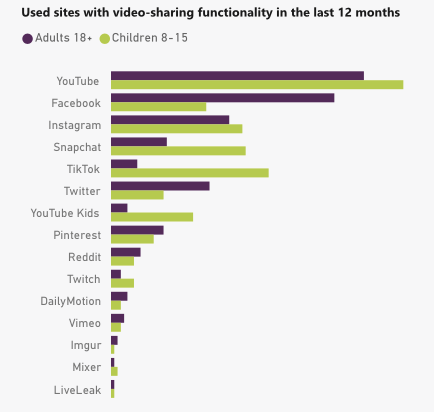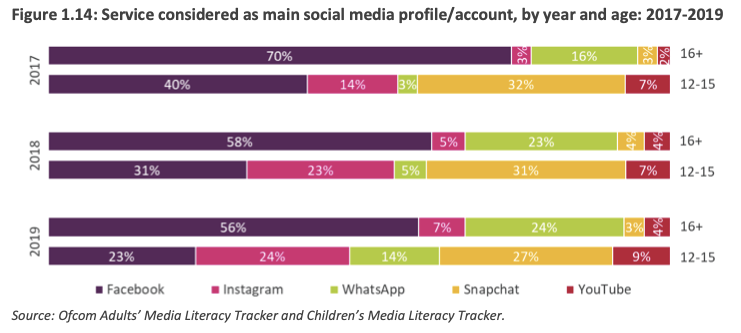What is happening with social media?
Amongst the detail, the recent Online Nation report reveals the direction in which social media seem to be heading. The visual is becoming increasingly dominant & the social media ecology is changing.

Last week Ofcom released their 2020 Online Nation report. Published as both a ‘narrative report’ and an ‘interactive report’, it covers a wide-range of matters concerning Internet use, industry revenues and consumer attitudes. I thought I’d use this post to offer some very brief reflections on the things that stood out to me whilst reading the report.
1. Lockdown has accelerated some existing trends
Although the report is mostly based on data from 2019, it still includes some early information on the impact of the pandemic on Internet use. For instance, the report observes that:
‘TikTok increased its reach among adults in the UK from 5.4 million to 12.9 million between January and April 2020; Houseparty increased from 175,000 to 4 million; Zoom reached 13 million adult internet users in April, up from 659,000 in January’.
TikTok’s increase in ‘reach’, more than doubling its UK user base in a four month period, represents a fairly dramatic rise. Even despite this scale, it is perhaps not entirely surprising. TikTok was already on a steep upward trajectory, yet this is still a huge acceleration in usage amongst UK adults.
TikTok can no longer be dismissed as a trivial or ephemeral outsider. Similarly, the even more dramatic increases in the use of video meeting providers is another product of the times - with distanced social life forcing interactions into online spaces. TikTok is likely to maintain these sudden gains, whereas Zoom and Houseparty seem unlikely to maintain such high numbers of active users in the future - they are likely though to level out at much higher numbers than in the past.
2. Facebook’s dominance might be challenged fairly soon, especially with social media fragmenting a little
Some ongoing changes in social media are hinted at by the reported figures from 2019. The chart below shows those who have reported using sites with video-sharing functionality in the last 12 months. The lack of breakdown of age categories amongst adults makes it hard to see anything nuanced about the varied relations between age and social media here, but, as expected, it does show much higher usage of Snapchat and TikTok amongst younger people. Youtube appeals across the age groups, but Facebook appears to be creating some division amongst social media users. It is clear below that Facebook holds relatively little appeal amongst the younger social media population compared to the more visually focused and newer providers. It seems that Facebook's dominance (as a specific social media platform if not as a company) may yet be challenged in the coming years.

3. Social media are continuing to become even more visually orientated
Wherever you look, visually orientated social media are gaining traction. The figure below takes the ‘online population' and measures the reach of particular sites amongst that population. This indicates the density of coverage and scale of usage and exposure. I'd suggest ignoring the average time calculations here and just looking in the ‘reach’ column. Note here that in 2019, before the massive recent increase in early 2020, TikTok was already reaching 10% of the online population. That is some way from the saturation of ‘Facebook and Messenger’ (at 95%), but the massive recent increases for TikTok will have dramatically increased its percentage. TikTok has the benefit of having space for expansion, particularly as users move towards holding more than one social media account.
It is worth remembering that Facebook own the top three sites here too - the variety of social media platforms does not necessarily transformed the concentration of power and ownership.

The reported frequency of consumption of video content as accounted for in the chart below adds a further impression of the role social media are playing in everyday consumption and also the importance of visual content across platforms. These are frequently consumed sources of content.

4. The hierarchy of social media profiles may be shifting
The above provides insight into the relative reach of the different social media sites, but it gives little sense of how individuals approach and manage multiple social media profiles. Individuals who have multiple accounts are likely to have some sort of hierarchy of their social media. Whereas the chart below, which indicates the social media account that is considered the main account, gives a stronger sense of the relative importance of particular social media sites to individuals (getting people to list their social media profiles in terms of importance would have provided an interesting addendum here). The chart shows instantly the relative decline in centrality of Facebook profiles amongst age categories across the three years. So although Facebook’s reach has been maintained (see above) its relative importance to individuals appears to be eroding. Reach is maintained but concentration is diluted. This could be onterpreted as an early a sign of a downward trajectory for the Facebook platform - it may be reaching widely across users but it is becoming more commonplace for people to attach greater importance to other social media profiles.
In the space created we find a group of social media sites of which instagram and WhatsApp have grown in significance - and Snapchat for the younger age group. Note here that TikTok was not included and would likely have impacted on the results in 2019 had it been so. Again though, a wider variety of site usage does not necessarily disperse the concentration of ownership and power.

5. There is evidence of the increased role of social media in news consumption
Clearly, an important aspect of social media is the role they take on in mediating news. This has been widely discussed. It is now obvious that people's sense of current affairs is increasingly determined by their social media news feeds. The below chart reflects a longer term reduction in traditional media as a source of news and an increase in the role of social media as a news source. Setting aside the loose category of ‘Internet’ used below (which could include newspapers), it is the 5% rise in just one year in social media as a news source that is notable (taking it to 49%). Social media networks and algorithms are taking on a greater role in shaping news awareness and in mediating the public sphere. If we link that to the trends above, this news content is also more likely to be visually orientated and, therefore, to circulate and fit within the logic of visual social media. This combination may have significant consequences in the future for the type of news that is made and encountered, with stories that can be visualised in different ways (through images, video or data viz) becoming more prominent.

The practices of accessing news through social media is explored a little further in the following chart. Broken down by platform, it provides insights into how news is accessed. It also suggests that combinations of active and passive approaches toward the use of social media are reported - these will inevitably impact on the news that is discovered and consumed. The bottom five entries in the chart are based on people following specific news sources - such as publications, journalists and news programmes. These represent a direct engagement with news sources of different types. The second and third entries start to factor in broader network effects, with the source of news being content shared by other people in the network. The top entry, which is the most widely used source of news, is the trending list.
It is important to note, however, that all of the below are likely to be mediated in some way by the algorithmic sorting processes contained within news feeds.

The changing social media ecology
This Online Nation report gives only a snapshot, but it does begin to suggest that there are some longer trends that are continuing. Not least, the move toward more visual forms of social media (based around images, Gifs and video content) continues at some pace - a pace that may have quickened with the remote and distant months of 2020. The other key change is the continued growth of the messaging apps. The establishment of WhatsApp in particular was largely a product of the difficulty of sending quick messages and images through mobile phone SMS texting. It has now taken on a much broader role in social connections and in group and interpersonal relations. We have these competing tendencies in social media, one is to reveal and broadcast and the other is message. One is public the other is private. But both are increasingly visual.
If I were to make a prediction, I’d suggest that the social media ecology will look very different in the next 5 to 10 years. What currently looks solid is much more prone to change than it might appear. The features of the report that I’ve picked out above are implicitly hinting at what might happen next. There are clearly generational shifts at play. The immobility of networks mean that it is unlikely that younger people will suddenly switch over to a different platform at a certain age - it is unlikely that ageing will draw people across to Facebook if they are not already using it. And so we might see something that looks quite different as the new networks continue to grow and as these emergent networks remain located within different social media providers.
One thing we might see is that where multiple social media profiles are held by an individual, their preference or hierarchy of importance might alter over time. Although networks can’t easily move between social media, the way that people are using a variety of social media in parallel also tells us something else. They have contingencies and they are already engaging in practices that mean that one social media platform could easily be left behind in favour of another - with users either focusing their attention on their remaining profiles or creating space for a new and emergent platform to replace its abandoned predecessor.
Networks don’t easily move, but allegiances can switch between established networks. The push towards visual content and messaging has already facilitated some recalibration in the field, more will follow, especially if new trends start to emerge that are suited to one particular platform (or even to a new social media provider that we are yet to be aware of). The quick success of both TikTok and Zoom is telling us that the media ecology can change quickly and that it is a little more volatile than it appears. If the social media ecology does continue to transform, the remaining question is one of ownership: will it remain as concentrated as it has in the past? This takes us back to the question of whether the tech sector can really be changed.


